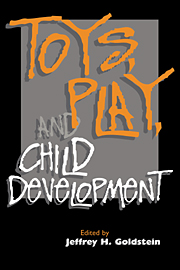Book contents
- Frontmatter
- Contents
- Acknowledgments
- List of contributors
- Introduction
- 1 Imaginative play and adaptive development
- 2 Play, toys, and language
- 3 Educational toys, creative toys
- 4 The war play debate
- 5 War toys and aggressive play scenes
- 6 Sex differences in toy play and use of video games
- 7 Does play prepare the future?
- 8 Play as healing
- References
- Name index
- Subject index
3 - Educational toys, creative toys
Published online by Cambridge University Press: 07 October 2009
- Frontmatter
- Contents
- Acknowledgments
- List of contributors
- Introduction
- 1 Imaginative play and adaptive development
- 2 Play, toys, and language
- 3 Educational toys, creative toys
- 4 The war play debate
- 5 War toys and aggressive play scenes
- 6 Sex differences in toy play and use of video games
- 7 Does play prepare the future?
- 8 Play as healing
- References
- Name index
- Subject index
Summary
The terms educational toys and creative toys are related in the sense that they both attribute human qualities to inanimate objects. Although no one with common sense believes that an object, by itself, can teach or that other inanimate objects can be creative all by themselves, the classification has caused much misunderstanding, not least because it suggests a polarization; the opposite of an educational toy would be a noneducational toy, which would inhibit learning, and the opposite of a creative toy would be a noncreative toy, which would suppress creativity. In fact, this interpretation is often used, particularly by teachers and parents. This chapter examines the background as well as the consequences of the labels educational toys and creative toys and discusses, on the basis of international research on children and toys, various aspects of the function of toys in children's learning and fantasy play.
The rebirth of the educational toy
It is important to note that the label educational toy is by no means a new invention. The purpose of toys has practically always been educational. The bows and arrows that little boys in ancient Rome were given to play with were undoubtedly regarded as vehicles for training future warrior mastery. And when the children of a peasant culture played family – the boys with farming tools and hunting weapons and the girls with wooden log dolls and miniature cooking utensils – they were supposed to practice their future adult roles in the society.
- Type
- Chapter
- Information
- Toys, Play, and Child Development , pp. 46 - 66Publisher: Cambridge University PressPrint publication year: 1994
- 18
- Cited by



